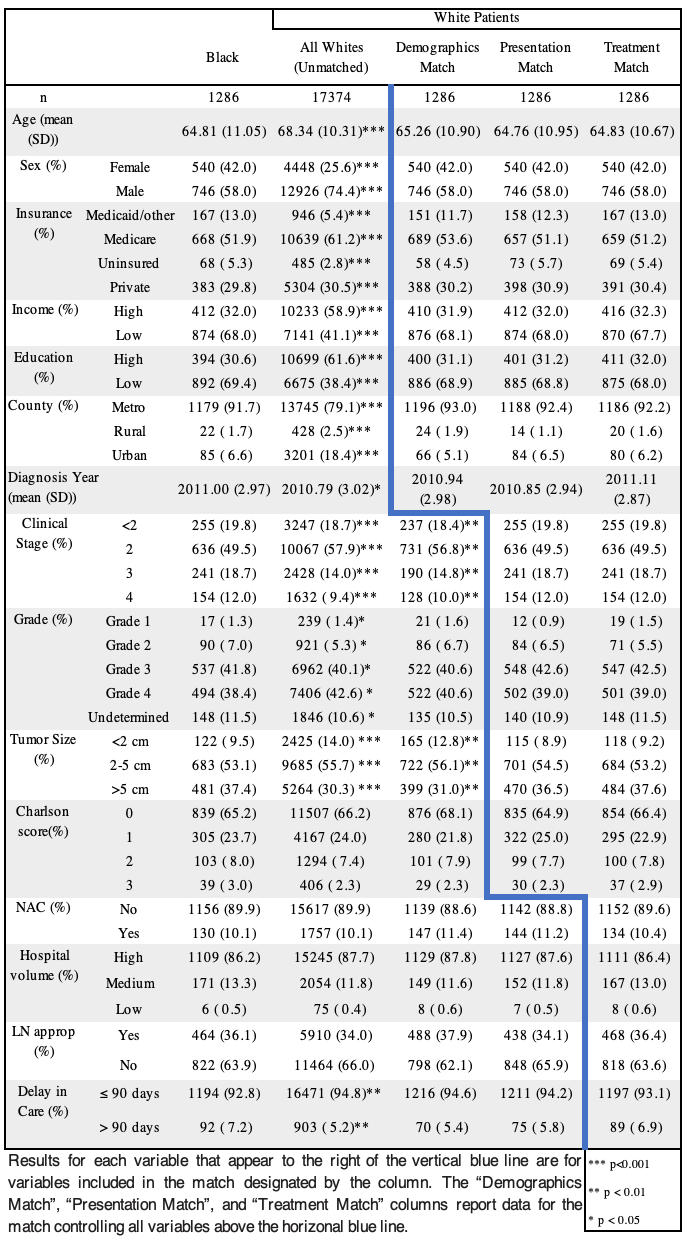Back
Poster, Podium & Video Sessions
Moderated Poster
MP42: Bladder Cancer: Epidemiology & Evaluation II
MP42-14: Characteristics Contributing to Survival Differences Between Black and White Patients Following Radical Cystectomy
Sunday, May 15, 2022
10:30 AM – 11:45 AM
Location: Room 225
Shoshana Rosenzweig*, John Sfakianos, Reza Mehrazin, Peter Wiklund, Nikhil Waingankar, New York, NY

Shoshana Rosenzweig
Icahn School of Medicine at Mount Sinai
Poster Presenter(s)
Introduction: To determine if demographic, presentation, or treatment characteristics contribute to racial disparities in overall survival(OS) following radical cystectomy(RC).
Methods: 1286 black patients (BP) in the 2004-16 National Cancer Database underwent RC. Three sets of white patients (WP) selected from 17374 white patients who underwent RC were matched to the black cohort on demographics (age, gender, insurance, income, education, county, year), presentation (demographics variables, clinical stage, grade, tumor size, Charlson score), and treatment (demographic and presentation variables, appropriate lymph node dissection, hospital volume, neoadjuvant chemotherapy (NAC), delay in care). Delay in care was defined as >90-days from diagnosis to first surgery. A propensity score was calculated for each patient using a logistic regression of black vs white patients on matched variables. The propensity estimate was a variable in each match to ensure match balance. Chi-square and Kruskal-Wallis tests were used to compare categorical and continuous variables. P<0.05 was considered significant.
Results: All matched variables had a standardized difference =.06, indicating a strong match. 5-year OS was 40.4% and 35.6% for unmatched white and black patients (p <.001). Following the demographic and presentation match, the OS for the white cohorts decreased to 39.2% and 39.1%, closer to the black 35.6% OS rate, but still significantly different. The treatment match accounted for the largest attenuation resulting in a 1.1% OS difference (white 36.7%, black 35.6%; p=0.32). In the presentation match, 7.2% of BP vs. 5.8% of WP had a delay in care and 10.1% of BP vs. 11.2% of WP received NAC. Treatment match resulted in a 0.3% difference between groups for delay in care and NAC.
Conclusions: Our analysis found a 5% OS difference between black and white patients. A primary source of this disparity is due to treatment-related factors. Further research is needed to better characterize these disparities and study strategies that can promote equitable treatment for bladder cancer.
Source of Funding: na


Methods: 1286 black patients (BP) in the 2004-16 National Cancer Database underwent RC. Three sets of white patients (WP) selected from 17374 white patients who underwent RC were matched to the black cohort on demographics (age, gender, insurance, income, education, county, year), presentation (demographics variables, clinical stage, grade, tumor size, Charlson score), and treatment (demographic and presentation variables, appropriate lymph node dissection, hospital volume, neoadjuvant chemotherapy (NAC), delay in care). Delay in care was defined as >90-days from diagnosis to first surgery. A propensity score was calculated for each patient using a logistic regression of black vs white patients on matched variables. The propensity estimate was a variable in each match to ensure match balance. Chi-square and Kruskal-Wallis tests were used to compare categorical and continuous variables. P<0.05 was considered significant.
Results: All matched variables had a standardized difference =.06, indicating a strong match. 5-year OS was 40.4% and 35.6% for unmatched white and black patients (p <.001). Following the demographic and presentation match, the OS for the white cohorts decreased to 39.2% and 39.1%, closer to the black 35.6% OS rate, but still significantly different. The treatment match accounted for the largest attenuation resulting in a 1.1% OS difference (white 36.7%, black 35.6%; p=0.32). In the presentation match, 7.2% of BP vs. 5.8% of WP had a delay in care and 10.1% of BP vs. 11.2% of WP received NAC. Treatment match resulted in a 0.3% difference between groups for delay in care and NAC.
Conclusions: Our analysis found a 5% OS difference between black and white patients. A primary source of this disparity is due to treatment-related factors. Further research is needed to better characterize these disparities and study strategies that can promote equitable treatment for bladder cancer.
Source of Funding: na



.jpg)
.jpg)